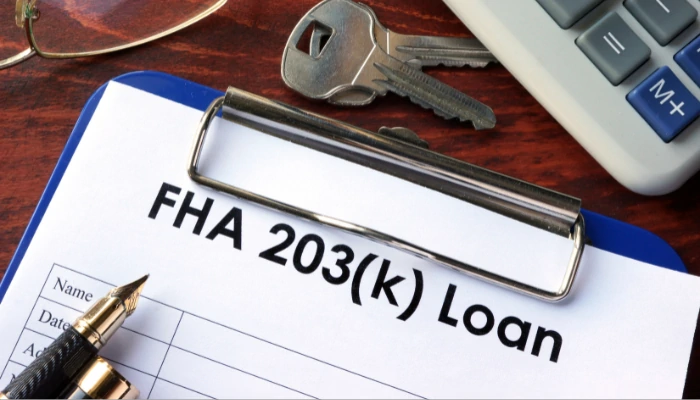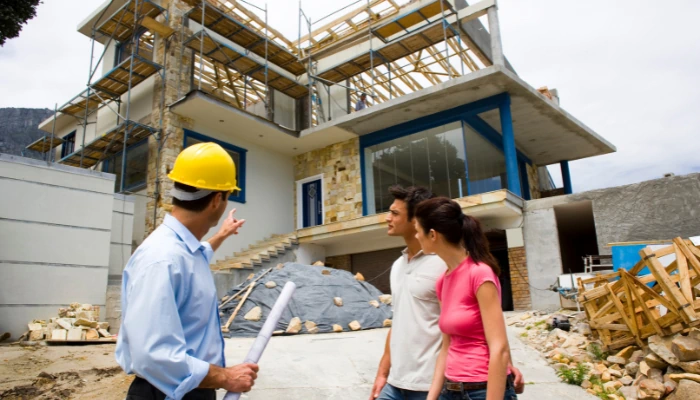Unlock Your Dream Home with The Ultimate 203k FHA Loan Guide
Dive into the world of homeownership with our comprehensive guide to the 203k FHA loan. Whether you’re eyeing a fixer-upper or envisioning a custom renovation, this guide lays out everything you need to know to make informed decisions.
From the basics of the 203k FHA loan process to insider tips on maximizing your investment, we’ve got you covered.

Introduction
Imagine discovering a home with undeniable potential, its charm hidden beneath years of neglect. This house isn’t just a structure; it’s a canvas awaiting your creative touch to transform it into a masterpiece of comfort and style. Enter the 203k FHA loan, a unique financial tool designed for visionaries who see beyond the decay to the possibilities that lie beneath. This isn’t just about buying a house; it’s about creating a home with your personal imprint.
The 203k FHA loan is more than a mortgage—it’s your ticket to customizing a fixer-upper into your dream home. Whether it’s reviving a quaint cottage needing a few tweaks or overhauling a rundown mansion that screams for a total rehab, this loan packages the purchase price and the renovation costs into one single investment. This holistic financing solution opens up doors to properties that might otherwise be overlooked or beyond reach, due to financial constraints or competition from buyers with ready cash for move-in-ready homes.
Think of this as your opportunity to star in your own version of a home renovation show, where you’re the lead character transforming not just a building, but crafting a vibrant environment that reflects your dreams and desires. With a 203k loan, you step into a role that could rival any house flipper show on TV, complete with the dramatic reveal of a beautifully renovated home and the satisfaction of knowing you increased your new property’s value from day one.
Flip it To Yourself
Unlike typical home flippers who aim to quickly renovate and sell for profit, as a homeowner utilizing a 203k loan, the profit that would have gone to a flipper now becomes equity for you. This significant shift means that every dollar you invest in your renovation not only enhances your living experience but also builds long-term financial stability.
An ADU Supercharges the 203k Loan
Moreover, incorporating an Accessory Dwelling Unit (ADU) into your renovation plans can amplify these benefits dramatically. Adding an ADU—an independent living space on your property such as a converted garage, basement, or a new backyard unit—can significantly boost your property’s value and functionality. It creates an additional source of income if you choose to rent it out, which can help pay down your mortgage or fund other expenses. Furthermore, lenders will count potential rental income from the ADU towards your total income, potentially qualifying you for a larger loan amount under the 203k program. This strategy enhances not just your living standards but also your financial leverage.
It’s a scenario where the end credits roll up to an improved home and a solid financial future, filled with the equity built through your own efforts and vision. Here, the profit is not measured just by immediate returns but by sustainable value that grows with your home. This approach turns traditional flipping on its head, giving you both the starring role in your renovation drama and the director’s chair for your financial future.
Chapter 1: The Basics of 203k FHA Loans
A 203k FHA loan isn’t just a financial tool—it’s a lifeline to potential homeowners who want to restore and improve their homes in ways that traditional mortgages would never allow. At its core, this loan is a government-backed mortgage that encapsulates both the cost of buying a home and the expenses needed for its rehabilitation. It’s a part of the Federal Housing Administration’s (FHA) primary offerings, crafted to make homeownership accessible and to revitalize communities one renovation at a time.
What Sets It Apart
Unlike conventional loans that prefer properties in “ready-to-move-in” condition, the 203k loan is designed for homes that are one or more years old and need a little (or a lot of) TLC. It can cover a vast range of improvements: from essential repairs like fixing a leaky roof or updating an aging HVAC system to aesthetic upgrades like redoing the kitchen or adding an extra bathroom for convenience. The loan even extends to significant structural repairs including foundation work, making it a versatile tool for comprehensive property improvements.

Why It’s Better
The beauty of the 203k loan lies in its simplicity and efficiency. Traditional financing might require homeowners to take out multiple loans: one for purchasing the property and others for various renovation projects. This not only complicates the financial process but often makes it more expensive. The 203k loan simplifies this by consolidating all costs into one single mortgage. This unified approach not only streamlines the financing but also makes the renovation process more manageable and less intimidating.
It’s also a boon for community revitalization. By allowing buyers to invest in older, perhaps neglected properties and turn them into valuable community assets, 203k loans can help breathe new life into declining neighborhoods. This not only improves the quality of housing but also boosts the overall property values in the area, contributing to broader economic revitalization.
In essence, the 203k loan is more than a financial instrument; it’s a catalyst for transformation. It provides aspiring homeowners the unique opportunity to embark on a dual journey of buying and customizing a home that truly reflects their vision. Whether you’re a first-time buyer or a seasoned property developer, the 203k loan empowers you to take the reins of your home renovation project, turning a potential house into your dream home.
Chapter 2: Why 203k Loans Are More Practical for LA Residents Now?
The script for homeownership in high-cost-of-living (HCOL) areas like Los Angeles is being rewritten by the evolving features of the 203k FHA loan. This financial tool has adapted to the unique challenges of the city’s dynamic real estate market, becoming a key player in making the dream of personalized, valuable, and impactful homeownership more attainable for a broader audience.
Increased Loan Limits: Expanding the Stage
One of the most significant updates for 203k loans in HCOL areas has been the increase in FHA loan limits. Reflecting the high property values of cities like Los Angeles, these adjusted limits have expanded the range of homes eligible under the 203k program. Now, more properties can qualify for renovation loans, broadening the scope for potential homeowners to find and transform older or distressed properties even in upscale neighborhoods. This change means that buying and renovating in high-priced markets is no longer just a plotline for the wealthy; it’s accessible to a wider range of buyers, democratizing the process of creating dream homes.
Adapting to Market Needs: Strategic Financing for Competitive Edges
In Los Angeles, where the real estate market feels as competitive as a Hollywood audition, the 203k loan offers a unique advantage. Properties requiring extensive updates tend to be less desirable to buyers who prefer move-in-ready homes and thus often have fewer competing offers. The 203k loan simplifies the challenge of purchasing such properties by combining the cost of the home and the renovation into one manageable mortgage, making it easier for buyers to consider homes that need work. This approach not only helps buyers potentially get a better deal but also reduces the competition they might otherwise face.

Practicality in Financing Renovations: Supporting the Set Design
Renovating in Los Angeles isn’t cheap, with costs that can skyrocket depending on the scope and scale of the project. The 203k loan addresses this head-on by offering a streamlined financing option that includes a wide range of renovation expenses. This means homeowners can undertake significant updates without the need to secure separate, high-interest loans or deplete their savings. Whether it’s upgrading an outdated kitchen or overhauling a dilapidated roof, the 203k loan covers these costs, making it a practical choice for substantial home improvements.
Flexibility for Diverse Projects: Catering to LA’s Creative Vision
Los Angeles is celebrated for its architectural diversity and creativity, which is mirrored in the type of home renovations undertaken by its residents. From the restoration of a classic Hollywood bungalow to the modernization of a mid-century gem, the 203k loan supports a wide array of project types. This flexibility is crucial in a city where personalization and style are key to property appeal. It allows homeowners to tailor renovations to their unique aesthetic and functional needs, supporting innovative projects that might not qualify under more traditional financing models.
The updated features of the 203k FHA loan script a compelling narrative for why these loans are now more practical and appealing for residents of Los Angeles and similar urban areas. By increasing loan limits, offering strategic advantages in a competitive market, providing practical financing options, and allowing for diverse renovation projects, the 203k loan is helping more people than ever write their own success stories in homeownership and property renovation. Whether you’re looking to star in your own home transformation series or simply seeking a supporting role in a community revitalization project, the 203k loan is ready to help you turn that dream into a reality.
Chapter 3: Types of 203k FHA Loans
Navigating the world of 203k FHA loans is like choosing your adventure in the sprawling city of Los Angeles. Just as LA offers both the laid-back beach vibes and the glitz and glamour of Hollywood, the 203k loan program presents two distinct paths: the Standard (Full) 203k and the Limited (Streamline) 203k. Understanding the differences between these two options is crucial for selecting the right renovation route for your needs.
Standard (Full) 203k Loan: The Director’s Cut
Imagine you’ve stumbled upon a classic LA fixer-upper, a home with bones so good it makes your heart race, but it needs more than a little nip and tuck to shine. Enter the Standard 203k loan, the director’s cut of renovation financing. This version is designed for projects requiring structural work or renovations exceeding $35,000. It’s the blockbuster option, supporting extensive transformations such as room additions, complete kitchen rebuilds, or foundation repairs. The Standard 203k is a powerful tool for those ambitious projects that can turn a neglected structure into a masterpiece of home design.
But, as with any epic production, there’s a bit more behind-the-scenes action. The process involves hiring a HUD consultant who oversees the project, ensuring renovations are up to code and within budget. This consultant is like your personal director, guiding the renovation from script to screen. Ideal for properties that need significant rehabilitation, the Standard 203k can finance not only the purchase price and renovations but also temporary housing if the home isn’t habitable during renovations.

Limited (Streamline) 203k Loan: The Indie Project
Now, let’s say your find is more of an indie project. It’s charming, with great potential, but it needs updates and repairs that don’t involve structural changes or complex renovations. The Limited 203k loan, or the Streamline version, is tailored for these scenarios. Perfect for projects with a renovation budget of $35,000 or less, this loan streamlines the process, covering cosmetic updates, appliance replacements, and minor repairs.There’s no need for a HUD consultant, making it a more straightforward and potentially quicker option. Think of it as the indie film of 203k loans—smaller budget, less complexity, but with plenty of potential for impact. It’s suited for buyers who want to make a property their own without the drama of major construction.
Choosing Your Adventure
Deciding between the Standard and Limited 203k loans comes down to the scope of your renovation dreams. Are you looking to undertake a major overhaul or simply refresh and repair? The Standard 203k offers the breadth and support for comprehensive projects, while the Limited 203k provides a simpler, more direct path for smaller endeavors. Each has its place in the landscape of home renovation, allowing you to tailor your project to your vision, budget, and needs.
Chapter 4: Eligibility and Requirements
Just as every aspiring star needs to meet certain criteria to land a role in Hollywood, potential homeowners must also satisfy specific eligibility requirements to qualify for a 203k FHA loan. This chapter will guide you through the “casting process” of securing this versatile financial tool, ensuring you know exactly what’s needed to step into the spotlight of your renovation project.
Who Qualifies and Why
First and foremost, the 203k loan isn’t exclusive to seasoned property developers or the financially elite—it’s designed for everyday people looking to turn less-than-perfect houses into their ideal homes. The primary qualifiers for this loan are straightforward: you need to be an individual homeowner or prospective buyer. Sorry, corporate entities and investors looking to flip properties for a quick profit—the 203k is meant for those who are in it for the long haul, planning to live in the home and contribute to the neighborhood’s improvement.
Property Eligibility: Auditioning Your Home
Not every property can play the lead role in your renovation saga. To be eligible for a 203k loan, the home must be at least one year old, which means brand-new constructions don’t make the cut. The program covers a variety of property types including single-family homes, multi-family units (up to four households), and mixed-use buildings, provided they are primarily residential. Condominiums can also qualify, but only for interior work. The idea is to finance improvements that enhance livability and usability, transforming overlooked or aging properties into homes fit for the silver screen.

Financial Requirements: Securing Your Role
Just like securing a role in a blockbuster movie, ensuring you meet the financial requirements of the 203k loan is crucial:
Credit Score: A credit score of at least 620 is typically required, acting as your audition tape. It shows lenders that you have a history of managing credit well and making timely payments—qualities that are essential for taking on a significant financial commitment.
Down Payment: Think of this as your investment in the production. You’ll need at least 3.5% of the total loan amount, which includes both the purchase price and the estimated costs of renovations. This modest down payment makes the 203k accessible to a wide range of homebuyers, much like how independent films strive to be accessible to a diverse audience.
Debt-to-Income Ratio (DTI): Your DTI should ideally be no more than 43%. This ratio measures your total monthly debt against your gross monthly income, ensuring you aren’t over-leveraged. It’s like a director ensuring there’s enough budget left to complete post-production without compromising the movie’s quality.

Community Impact: Beyond Individual Achievements
The purpose of the 203k loan transcends individual home improvements. It’s also about enhancing communities by revitalizing older homes, much like how a successful film can boost local economies and community pride. By encouraging renovations in declining neighborhoods, this loan helps increase property values and improve living conditions across the community, supporting a narrative of renewal and resilience.
In essence, the 203k FHA loan offers a unique opportunity for you to star in your own home renovation story. It sets the stage for transforming potential-laden properties into homes that are not only more comfortable and modern but also more valuable. Whether you are a first-time homebuyer or a seasoned homeowner looking for a new project, understanding and meeting these eligibility requirements is your first step towards achieving your property goals. This chapter arms you with the knowledge you need to navigate the audition process successfully and ensure your home renovation dreams get the green light.
Chapter 5: The Application Process – A Step-by-Step Guide
Embarking on the 203k loan application journey is akin to plotting a course through LA’s famed traffic – it requires patience, a solid plan, and perhaps a bit of insider knowledge to navigate smoothly. Here’s your roadmap, with a few pro tips from yours truly.

1. Documentation Gathering: Your Prep Work
Before diving in, get your ducks in a row. This means rounding up all necessary financial documentation – think tax returns, W-2s, pay stubs, and a detailed list of debts and assets. Preparation here is key. It’s like knowing your lines before stepping onto a Hollywood set.
2. Finding Your Guide: The Right Lender
Not all lenders are fluent in the language of 203k loans. You’ll want a partner who’s not just familiar but experienced. Ask for references, look for reviews, and don’t shy away from interviewing them. Think of it as casting for the lead role in your renovation saga – you want the best of the best.
In my journey, finding a lender who was as enthusiastic about my project as I was became a cornerstone of success. They were instrumental in not just guiding me through the paperwork but also in ensuring the project stayed true to vision and budget.
3. The Application: Submitting Your Script
With your lender chosen, it’s time to submit your application. This includes your financial documentation, a proposal for the property, and, crucially, a detailed estimate of renovation costs. A good lender will walk you through this process, ensuring your application shines as brightly as the Hollywood sign at night.
4. The Review: Waiting for the Green Light
Like awaiting the premiere of a blockbuster, this part involves some patience. The lender will review your application, assess the proposed renovations, and likely require an appraisal of the property. It’s a thorough review, but one that’s essential for ensuring everything is in place for a successful project.
5. Closing: Signing Day
Upon approval, you’ll move to closing. This is when your dream project officially kicks off. Sign the paperwork, and the funds for both the purchase and the renovations are yours. It’s like the opening night – the anticipation is over, and it’s time to bring the vision to life.
Throughout this process, remember that preparation, the right partnerships, and a clear vision are your best allies. My own experience taught me that the right lender isn’t just a facilitator but a vital part of the renovation team, helping to navigate any bumps along the way. So, take the time to prepare thoroughly, choose wisely, and your 203k journey will be as rewarding as the final transformation of your property.
Chapter 6: Finding and Choosing Your Contractor
Imagine embarking on a culinary adventure without a chef or setting sail without a captain. That’s what diving into a renovation project without the right contractor feels like. This choice isn’t just crucial; it’s foundational to the success of your 203k journey. The right contractor doesn’t just bring your vision to life; they ensure the journey is as smooth as the California coast.
The Perfect Match
Finding a contractor familiar with the nuances of 203k loans is like finding a needle in a haystack. But, oh, is it worth the search. These pros know the playbook, understanding the specific requirements and deadlines that come with these loans. They’re not just builders; they’re navigators of the bureaucratic twists and turns, ensuring your project stays on track and within the guardrails set by your loan.

Seth’s Contractor Vetting Tips
- Experience Speaks Volumes: Prioritize contractors with a portfolio of 203k projects. Their experience can illuminate potential challenges and opportunities within your project, turning obstacles into stepping stones.
- References Are Gold: Dive into their past projects, seeking out reviews and testimonials. Contact previous clients if possible. The goal? To ensure their craftsmanship and reliability aren’t just claimed but proven.
- Communication is Key: Your contractor should be more than a builder; they should be a partner. Look for someone who listens, understands your vision, and communicates transparently. Remember, a good conversation can be the cornerstone of a successful project.
- Get It in Writing: A detailed contract isn’t just paperwork; it’s peace of mind. Ensure everything from the project scope to payment schedules is clearly outlined. This clarity can prevent potential headaches down the road.
From personal experience, the right contractor can make or break your renovation adventure. I recall partnering with a contractor on a seemingly daunting project. Their expertise with 203k loans turned what could have been a bureaucratic nightmare into a dream renovation. The key was their seamless communication and thorough understanding of the process, underscoring the importance of making an informed, thoughtful choice.
Chapter 7: The Renovation Range – Unleashing Potential
Embarking on a home renovation project with a 203k loan is like opening a treasure chest of possibilities. This chapter delves into how you can use this versatile financial tool to maximize the potential of your property, transforming it into a space that not only meets your needs but also enhances your investment.
A Spectrum of Possibilities
The 203k loan opens up a wide array of improvement options, from essential repairs to extensive overhauls, ensuring that every homeowner can tailor their project to reflect personal taste and functional requirements.
Capitalizing on ADU Opportunities
A key strategy to unlocking the full financial potential of your 203k loan is through the addition of an Accessory Dwelling Unit (ADU). Constructing an ADU, such as converting a garage into an independent living space or building a backyard cottage, can significantly increase your property’s value and versatility. More than just an enhancement, an ADU can be a pivotal financial asset:
- Income Generation: Renting out the ADU can provide a steady source of income, helping to offset mortgage costs and other expenses.
- Loan Qualification: Lenders often consider potential rental income when assessing your loan application, which means adding an ADU can actually increase the total loan amount you qualify for. This makes it easier to finance larger projects and improve your property’s market value.

From Minor Updates to Major Overhauls
Whether you’re making modest updates or undertaking a major transformation, the 203k loan supports a broad range of renovations:
- Minor Updates: Simple changes such as painting, installing new fixtures, or updating landscaping can significantly improve the aesthetics and curb appeal of your home.
- Major Renovations: The loan also covers extensive modifications, including kitchen remodels, bathroom overhauls, and even adding new rooms. These larger projects can transform your living space and significantly increase property value.
- Essential Upgrades: Crucial but often overlooked improvements like roofing repairs, plumbing updates, and electrical system overhauls are also eligible. These investments ensure the safety, efficiency, and longevity of your home.
Customization and Creativity
The 203k loan encourages personal expression in home renovation. It allows you to customize your living space to suit your lifestyle and preferences, potentially including unique features like a home cinema or a gourmet kitchen. This creative freedom not only enhances your living experience but also helps create a home that truly stands out in the housing market.
Emphasizing Flexibility
The flexibility of the 203k loan is one of its greatest strengths. It accommodates a wide range of budgets and project scopes, making it an ideal choice for nearly any type of renovation. Whether you are updating a single room or reimagining your entire property, the 203k loan provides the financial backing you need to complete your projects effectively and efficiently.
The 203k loan offers an expansive range of renovation possibilities, enabling homeowners to significantly enhance the functionality and aesthetic of their properties. The strategic addition of an ADU can be particularly beneficial, adding substantial value and income potential to your investment. By taking full advantage of this loan’s flexibility and the income-qualifying benefits of an ADU, you can maximize your property’s value and enjoy a beautifully customized home that serves as both a personal sanctuary and a financial asset.
Chapter 8: Financing Your Dream – Understanding Costs and Interest Rates
Entering the realm of 203k loans is akin to setting sail on the Pacific: exhilarating, vast, and not without its navigational challenges. Interest rates and loan costs are the compass and map of this journey, guiding your financial decisions and influencing the trajectory of your project.
Interest rates: The Currents that Guide
Interest rates on 203k loans are like the currents of the ocean – ever-changing and critically influential. While they may run slightly higher than traditional FHA loans due to the increased risk associated with renovations, they’re still competitive, especially when weighed against the backdrop of high-interest personal loans or credit cards. Think of it as paying a bit more for a first-class ticket, ensuring your renovation journey is as streamlined and supported as possible.
Loan Costs: Understanding the Landscape
Embarking on a 203k project involves various costs, from closing fees to a contingency reserve designed to cover unforeseen expenses. It’s akin to packing for an extended trip; you’ll want a well-stocked kit to handle unexpected twists. This reserve is not an additional cost but a safety net, ensuring your project can weather any storms without capsizing your finances.

Seth’s Financial navigation Tips
- Budget Wisely: Treat your renovation budget like a GPS, guiding every decision with precision and foresight. Account for every cost, from materials to labor, and set aside a portion for the unexpected. Remember, even the best-laid plans can encounter detours.
- Investment Mindset: Viewing your 203k project through the lens of investment can shift your perspective on costs. Each decision, from eco-friendly appliances to layout changes, should enhance the value of your home. It’s not just about spending; it’s about investing in your property’s future value.
- Expert Guidance: Partner with a lender who offers clarity and support. Just as a seasoned captain can navigate challenging waters, a skilled lender can guide you through the financial aspects of your 203k loan, from understanding interest rates to optimizing your loan structure.
Through my own ventures into 203k renovations, I’ve learned that a well-planned budget is the anchor that keeps your project grounded. Interest rates and costs are not hurdles but stepping stones, guiding your journey from a vision to a tangible, enhanced home. With the right mindset and strategic planning, financing your dream home becomes not just a possibility, but a thrilling reality.
Chapter 9: The Renovation Work – From Vision to Reality
Turning your vision for a dream home into reality with a 203k loan involves more than just ambition and creative ideas—it requires meticulous planning, a robust understanding of the renovation process, and proactive measures to ensure the journey is as smooth as possible. This chapter will guide you through setting realistic expectations for your renovation work, managing the process efficiently, and the critical role a thorough home inspection plays in this adventure.
Setting the Stage with a Solid Timeline
Creating a realistic timeline is your foundational script for renovation success. Just as in any well-planned event, understanding the sequence of activities and their duration helps manage both your expectations and those of the team working with you. Generally, you should plan for:
- Preparation and Design: This initial phase involves finalizing your renovation plans and getting the necessary permits. Depending on the complexity and local regulations, this can take several weeks to several months.
- Construction: The actual renovation work can vary significantly in length, from a few months for minor remodels to over a year for major reconstructions. During this phase, having a clear timeline helps keep the project on track and within budget.
Navigating the Renovation Process
Managing the renovation process effectively is crucial for keeping your project within scope and on schedule. This involves regular communication with your contractor, keeping a close eye on budget allocations, and making adjustments as needed:
- Regular Check-Ins: Schedule weekly meetings with your contractor to discuss the project’s progress, upcoming steps, and any issues that have arisen. These check-ins are vital for catching and addressing problems early.
- Budget Management: Keep a detailed ledger of all expenses. Unexpected costs can arise, especially in extensive renovations, so maintaining a contingency fund of at least 10-15% of the overall budget is wise.

The Crucial Role of a Thorough Home Inspection
Before diving into the renovations, a comprehensive home inspection is paramount. This step is often underestimated but can significantly impact the overall success of the project by identifying potential issues early on:
- Mitigating Risks: A detailed inspection can reveal hidden problems such as structural weaknesses, outdated wiring, or plumbing issues. Addressing these issues early can prevent costly and time-consuming repairs later.
- Informing the Renovation Plan: Insights from the home inspection can influence your renovation decisions, helping you prioritize certain upgrades or repairs. This ensures that your improvements are not only cosmetic but also functional and structurally sound.
- Budget Allocation: Knowing the home’s exact condition allows you to allocate your budget more effectively. You can avoid overspending on unnecessary modifications and instead focus on critical improvements that increase property value and living quality.
Overcoming Challenges
Throughout my experiences with 203k renovations, I’ve seen how a rigorous home inspection can make all the difference. In one memorable project, the inspection revealed significant water damage that was not visible during the initial walkthrough. By adjusting our plans to address this issue first, we were able to avoid what could have been a major disaster mid-project, saving money and stress in the long run.
The journey from vision to reality in home renovation can be complex, but with careful planning, continuous oversight, and proactive problem-solving, it is certainly achievable. A thorough home inspection before starting the work is not just a precaution; it’s a crucial step in ensuring that your renovated home is safe, sound, and exactly as you envisioned. By following these guidelines and incorporating practical project management practices, you can successfully navigate the renovation process and enjoy the rewards of a beautifully transformed home.
Chapter 10: Living with Your Loan – Post-Renovation Considerations
After the dust settles and the last contractor leaves, you stand at the threshold of your newly transformed home. The 203k loan journey doesn’t end with the renovation; it evolves into a new chapter of homeownership enriched by the value you’ve added to your property.
Exploring refinancing options
Post-renovation, homeowners might consider refinancing their 203k loan into a conventional mortgage. This can be a strategic move to lower interest rates or eliminate mortgage insurance. It’s a financial maneuver that can further solidify your investment, ensuring your renovated home continues to deliver returns in comfort, satisfaction, and value.

The Long-term Benefits
The true value of a 203k loan extends beyond the immediate gratification of transformation. It’s about long-term investment in your property’s potential and in your quality of life. Homes renovated with a 203k loan often see a substantial increase in value, a testament to the foresight and effort invested. This isn’t just a financial win; it’s about creating a space that truly feels like home, tailored to your needs and dreams.
Reflecting on past projects, I’m always struck by the profound impact of these transformations. Not just on the buildings themselves but on the lives of those who inhabit them. A 203k loan isn’t just a financial tool; it’s a catalyst for change, turning the dream of homeownership into a reality filled with possibilities. It underscores the belief that with the right support, vision, and dedication, any home can be turned into a sanctuary that reflects its owner’s aspirations, making the journey as rewarding as the destination.
Chapter 11: Debunking Common Misconceptions
Navigating the waters of 203k loans can sometimes feel like dispelling urban legends—everyone has heard a story or two that skews their perception. It’s time to set the record straight, illuminating the true potential and versatility of these loans.

Myth 1: They’re Too Complicated
Yes, 203k loans involve a few more steps than your standard mortgage, but they’re far from the bureaucratic nightmare some make them out to be. With the right lender and contractor in your corner, navigating the process is smoother than a Malibu sunset.
Myth 2: Only Major Renovations Qualify
As we’ve seen, 203k loans cover a spectrum as wide as the California coastline. From simple upgrades like a new roof or HVAC system to complete overhauls, these loans are designed to accommodate projects of all scopes and sizes.
Myth 3: The Interest Rates are prohibitive
While it’s true that rates might be slightly higher due to the nature of the loan, they’re competitive and often more favorable than the alternatives. Considering the loan’s ability to finance both your purchase and renovation, the slightly higher rate is a small price to pay for the convenience and capability it offers.
Seth’s Insight: “The biggest misconception about 203k loans? That they’re more trouble than they’re worth. In reality, they’re a golden ticket to transforming a property into your dream home. The key is understanding the process, setting realistic expectations, and seeing beyond the myths to the possibilities that await.”
Chapter 12: Final Thoughts and Advice From Seth
As we draw the curtains on our journey through the world of 203k loans, I want to leave you with some nuggets of wisdom, much like the cherished final scenes of a classic film that stay with you long after the credits roll. The path to transforming a property into your dream home is both an adventure and a challenge, but armed with the right tools and mindset, it’s a journey well worth embarking on.
Key takeaways for prospective borrowers
First and foremost, remember that a 203k loan is more than just a financial agreement; it’s a vehicle for transformation. It melds the practicalities of homeownership with the creative freedom of renovation, offering a unique opportunity to craft a space that truly reflects your vision and needs.

Embracing the 203k loan
View the 203k loan as your ally in the quest for a home that ticks all the boxes. It’s a testament to the idea that no property is beyond redemption, and with a bit of vision and effort, even the most rundown house can become a cherished home. The journey may require patience and flexibility, but the reward—a home tailored to your desires and needs—is incomparable.
Let’s make this a reality!
For those standing at the threshold, considering a 203k loan, my advice is to dive in. Start by educating yourself on the process, understanding both the commitments and the rewards. Seek out lenders with proven experience in 203k loans, and don’t shy away from asking for references or for their insights on past projects. Choose a contractor not just for their skillset, but for their ability to communicate and collaborate towards bringing your vision to life.
Above all, approach your project with an open heart and a clear vision. The road to transforming a fixer-upper into your dream home may have its share of twists and turns, but with a 203k loan in your toolkit, you’re well-equipped to navigate the journey. The possibilities are as vast as your imagination, and the outcome—a home that reflects your personal touch—is a testament to the power of perseverance, vision, and the right financing tool. Here’s to turning those renovation dreams into reality!